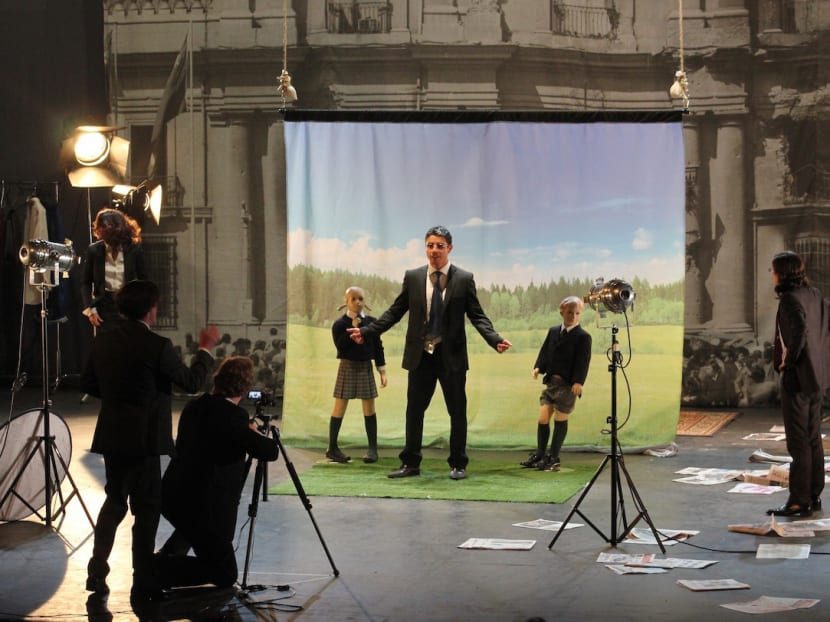The OPEN 2015: Toyo Ito’s tsunami moment, Chile’s Presidential dilemma
SINGAPORE — How does one deal with a national tragedy? What does one do after a catastrophe that wipes out so many people?

The Imagination Of The Future by Chilean group Teatro La Re-sentida at The OPEN. Photo: Pablo de la Fuente
SINGAPORE — How does one deal with a national tragedy? What does one do after a catastrophe that wipes out so many people?
Serious goatee-stroke-worthy questions you don’t normally deal with on a nice Saturday. Unless SIFA’s The OPEN is in town— with what has been its most disappointing and its most powerful events so far.
***
2013 Pritzker Prize-winning architect Toyo Ito kicked off his full-house keynote speech event at SOTA with a bit of background on his Home-For-All project, a laudable effort to bring communities together after the Great East Japan earthquake of 2011. In reaction to the boxy temporary homes that were built for the displaced, he started a project that got the community involved in building communal spaces. A reaction to modernist architecture’s way of isolating humans from everything, he explained, the inside and outside spaces overlapped in his huts.
Since we were talking about the earthquake, and knowing how much the event had profoundly affected and influenced Japanese artists around that time, I was expecting him to elaborate on this. The talk’s called The Role Of Tomorrow’s Architects, after all.
Instead, it turned into some kind of presentation on his recent projects, including a couple of condo and office properties in Singapore (in case you didn’t know, he designed VivoCity). Even setting aside the strange sensation I felt as we shifted gears from “noble endeavour” to a commerce-bent one, I couldn’t glean any new insights.
It was good to know that he pushes for the idea of architecture as “activity” and not as “product” (although photographs that are not of super expensive condos would probably have been more apt). But his point about bringing architecture to nature as a reaction to modernism’s limitation is a trend that’s already underway (which he has a hand in, of course).
I also found problematic how he pegged this discussion of modernism to what seems like an entirely Western framework — while he kept talking about the integration of inside and outside, of space embracing nature, all I could think of was: What would a tropical modernist architectural giant like the late Geoffrey Bawa say? “Been there, done that”?
Toyo Ito had answers to Saturday’s Big Questions, even if it wasn’t quite the exciting, groundbreaking ones we were hoping to hear. In contrast, Chilean group Teatro La Re-sentida’s The Imagination Of The Future offered no definite answers — but it sure asked a lot of bold questions.
***
Everyone I know has raved about Marco Layera’s theatrical dissection of that pivotal moment in Chilean history, a reimagining of then-President Salvador Allende’s defiant public speech on radio as the forces of the brutal Augusto Pinochet come knocking at his door in 1973. Allende’s death (officially a suicide) and Pincohet’s coup d’etat victory eventually resulted in the torture and deaths of thousands.
The Imagination Of The Future is shaping up to be the highlight of The OPEN — a production that’s so brash, so loud and so in-your-face (literally, in my case, as I had a camera shoved to my face) it’ll stick for a while in my mind.
The “what if” moment starts with Allende preparing his defiant speech amidst social unrest. It seems everyone has turned their backs on his socialist utopia but he’s still going on-air to say he’s not resigning.
It’s imagined, however, as a matter of spin and image, with his shrill ministers arguing about how to make him look more “cool”. The red backdrop makes him look like Stalin, someone says. So it’s replaced with a green field and mannequins of kids, while Allende wears a tracksuit.
“Angry” is a word that’s been commonly used to describe the show and it is, in often funny ways that makes you wince and groan. (The last time I saw something like this was probably PENG! Palast’s Germans-go-to-Israel-and-talk-about-the-Holocaust show The Holycoaster (S)hit Circus at the Singapore Fringe Festival in 2013.)
Like a crazed gunman firing all over the place, The Imagination Of The Future takes a dig at everyone: The artists are easily pushed around, a callous press and vicious netizens pounce on other people’s misery with glee, and government ministers are cocaine-snorting addicts (and did I mention shrill?).
At some point, it launches into slander-level tirades against Pinochet, Margaret Thatcher, current Mexican president Enrique Pena Nieto (who’s still under fire for the disappearance of 43 activist students) and Pope Francis for stuff we don’t know because the play also takes a dig at Singapore (they bring up a “Censored In Singapore” sign during this part as they did for a couple of nudity moments, including a “live” one in front of yours truly.)
There’s more, too. The United States’ president gets a scolding for all its Hannah Montana and “Show Me The Money”-inflected pop culture. There’s a mocking rap about the promises of socialism as banners featuring the faces of Allende, Che Guevara and Fidel Castro are unfurled, along with the children’s mannequin hanging from nooses — all to the tune of Cypress Hill’s Insane In The Brain.
The audience is taken on a guilt-trip as the performers bring out a poor child named Roberto and urges the audience to give $50 each to help secure his future. Yours truly gets singled out and, in true Stomp fashion, is embarrassingly put on the spot with a camera. Why are can’t we donate when we can obviously buy luxury goods, my accuser (shrilly) bemoans, before adding that I’d probably pay $50 for a blow job and, erm, attempts to do so.
A pretty traumatic moment, I have to say, but not as traumatic as the prediction that Roberto eventually dies from a stray bullet during a riot — a moment that’s chillingly enacted as a live video feed that shows the impact from the perspective of the bullet itself.
And finally, and most tellingly, the play takes a dig at Allende himself, who is portrayed as a naive, doddering old idealist with narcolepsy — who also has a cocaine habit and does not command the respect of a cabinet that urges him to rethink his position and to resign for the sake of the country.
In one dream sequence, a puppet girl, a future victim of Pinochet, warns him how things will change the day he dies. She also begins to guilt-trip him. For sticking to his plans of not resigning and dying as a hero, “(he) will be eternal and we will be forgotten”. The accusations continue to fly in before his equally dramatic death scene. “Your good intentions and love for people was never enough,” comes the accusation. Was this socialist dream was a bourgeois whim, goes another.
I love my onstage irreverence but I wasn’t sure about this one. While it’s an extremely potent and visceral piece of theatre (for which I might have gotten goosebumps if not for my red-faced moment), I can’t wrap my head around its shooting-spree politics and how it’s angry with apathetic/cheapskate people, socialists, fascists, Facebook users, incompetent/corrupt government leaders and Hollywood. (And just to remind you that everyone’s fair game, an archetypal silent court jester in the form of a man in an ape mask hangs around observing the absurdity of it all.)
Naturally, a non-Chilean like myself would not be able to access the piece the way a Chilean would — I’m not even going to go there. But surely the piece was trolling us when it reduces Allende to “good intentions” and “love for people” without painting a fuller context? He had led a fragile coalition that eventually splintered into different groups. His socialist attempts to nationalise the Chilean economy was unpopular among the rich and those who had something to lose. The Cold War also meant the US — via the CIA — was doing everything it can to destabilise left-leaning governments in South and Central America. Pinochet’s wasn’t the only coup d’etat by CIA-backed right-wing generals of that time — you had Paraguay, Bolivia, Uruguay, Argentina...
Surely it goes beyond the act of one man resigning?
In the programme, director Layera has implied the need to reexamine the symbol of Allende and his death. And yes, I agree that this piece has some pretty powerful implications for Chileans at an especially rocky moment in their post-Pinochet history. But the thing with symbols is that these have the power to transcend their origins. Allende — and what he stood for — could very well resonate outside of Chile in ways Layera, the play or even the Chile itself do not expect.
But the main issue for me here is a seeming lack of a moral compass. Make no mistake about it, The Imagination Of The Future’s palpable anger is a powerful wake-up call. But that missing compass (or if present, has a needle wildly swinging in all directions) is what could spell the difference between an aesthetically excellent self-righteous heckling experience and art that is transformative and liberating.








